Accreditation
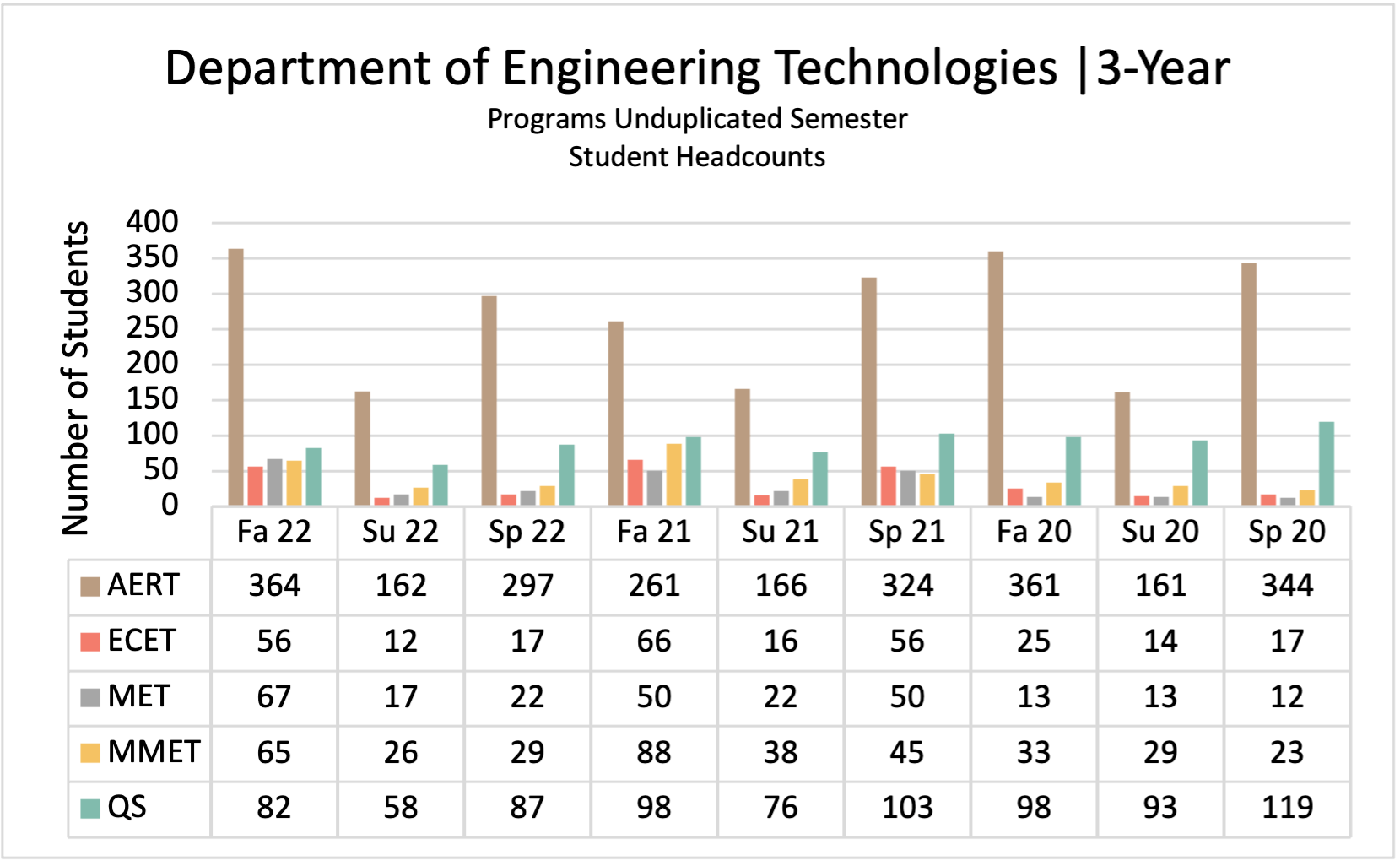
Learn about ABBI Accreditation at https://www.aabi.aero/about-aabi/
Student Outcomes
The first two student outcomes for Aviation Studies apply to AMO, and FTO. The third student outcome is exclusive to FTO. Upon completion of the baccalaureate degree, students in Aviation Studies will be capable of the following Student Outcomes (SO):
- SO 1: Solve aviation-related problems using knowledge, skills, and aptitudes gained in the program to assure productive outcomes;
- SO 2: Maintain professional and social relationships with others in developing, conducting, and promoting safe aviation operations; and
- SO 3: Students in the flight technology specialization are expected to plan, organize, conduct, and complete a safe and efficient flight in single-engine aircraft, in accordance with all legal requirements.
FTO Program Educational Goals*
Aviation Program Educational Goals: BGSU builds a collaborative, diverse, and inclusive community where creative ideas, new knowledge, and entrepreneurial achievements can benefit others in our region, the state of Ohio, the nation, and the world. Upon completion of the baccalaureate degree, students in the Aviation Studies program will be capable of the following Program Educational Goals (PEG):
- PEG 1: Create competent, skillful professional pilots and flight department leaders who can solve flight operations problems within the aviation industry;
- PEG 2: Develop crew resource management, operational risk management, and safety professionalism skills in students for their careers in the aviation industry;
- PEG 3: Impart professional, business, and ethical responsibility in the global aviation environment.
* The program educational goals are proposed and are in the approval process at the University level.
AMO Program Educational Goals*
Aviation Program Educational Goals: BGSU builds a collaborative, diverse, and inclusive community where creative ideas, new knowledge, and entrepreneurial achievements can benefit others in our region, the state of Ohio, the nation, and the world. Upon completion of the baccalaureate degree, students in the Aviation Studies program will be capable of the following Program Educational Goals (PEG):
- PEG 1: Create competent, skillful aviation professionals and leaders who can solve managerial and operational problems within the aviation industry;
- PEG 2: Develop a solid foundation of aviation management, operational risk management, organizational behavior, and safety professionalism in the aviation industry;
- PEG 3: Impart professional, business, and ethical responsibility in the global aviation environment.
* The educational goals are proposed and are in the approval process at the University level.
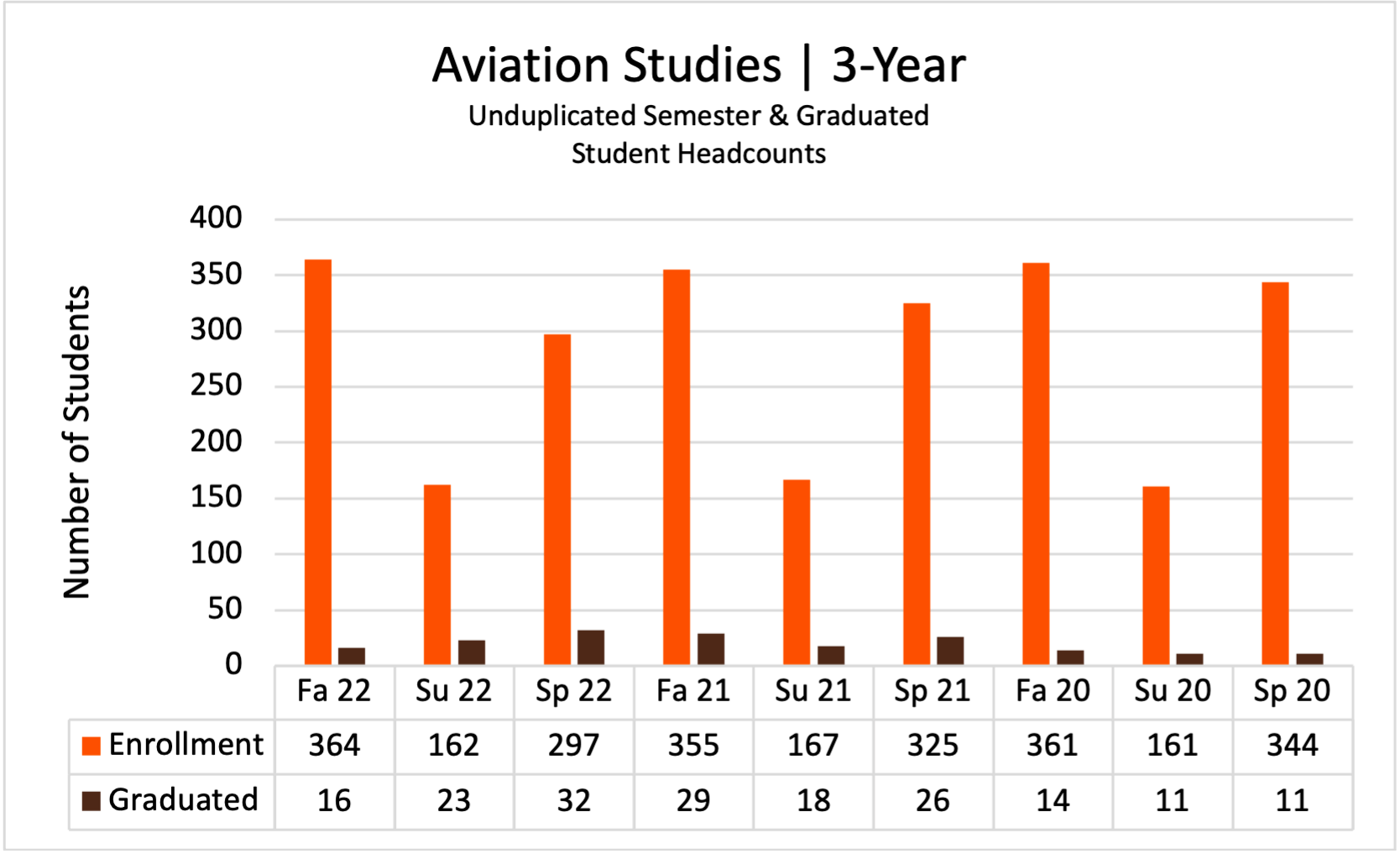
Program Educational Outcomes
The Mechanical and Manufacturing Engineering Technology program at BGSU expects the graduates within a few years of graduation to attain the following Program Educational Objectives (PEO).
- PEO 1: Are employed in the profession and advance through promotion;
- PEO 2: Are adept at working in teams and are proficient in social skills to perform effectively in the global technological corporate environment and community; and
- PEO 3: Remain technically competent through continuous education and professional engagement.
Student Outcomes
Upon completion of the baccalaureate degree, students in the Mechanical and Manufacturing Engineering Technology program will be capable of the following Student Outcomes (SO).
- SO 1: An ability to apply knowledge, techniques, skills and modern tools of mathematics, science, engineering, and technology to solve broadly defined engineering problems appropriate to the discipline;
- SO 2: An ability to design systems, components, or processes meeting specified needs for broadly defined engineering problems appropriate to the discipline;
- SO 3: An ability to apply written, oral, and graphical communication in broadly defined technical and non-technical environments; and an ability to identify and use appropriate technical literature;
- SO 4: An ability to conduct standard tests, measurements, and experiments and to analyze and interpret the results to improve processes; and
- SO 5: An ability to function effectively as a member as well as a leader on technical.
Chart Data
In the Fall 2021, the ENGT program was renamed to MMET so student numbers are combined starting in Fall 2021. This is reflected in the ENGT/Mechanical and Manufacturing Engineering Technology | 3-Year Unduplicated Semester & Graduated Student Headcounts chart data.
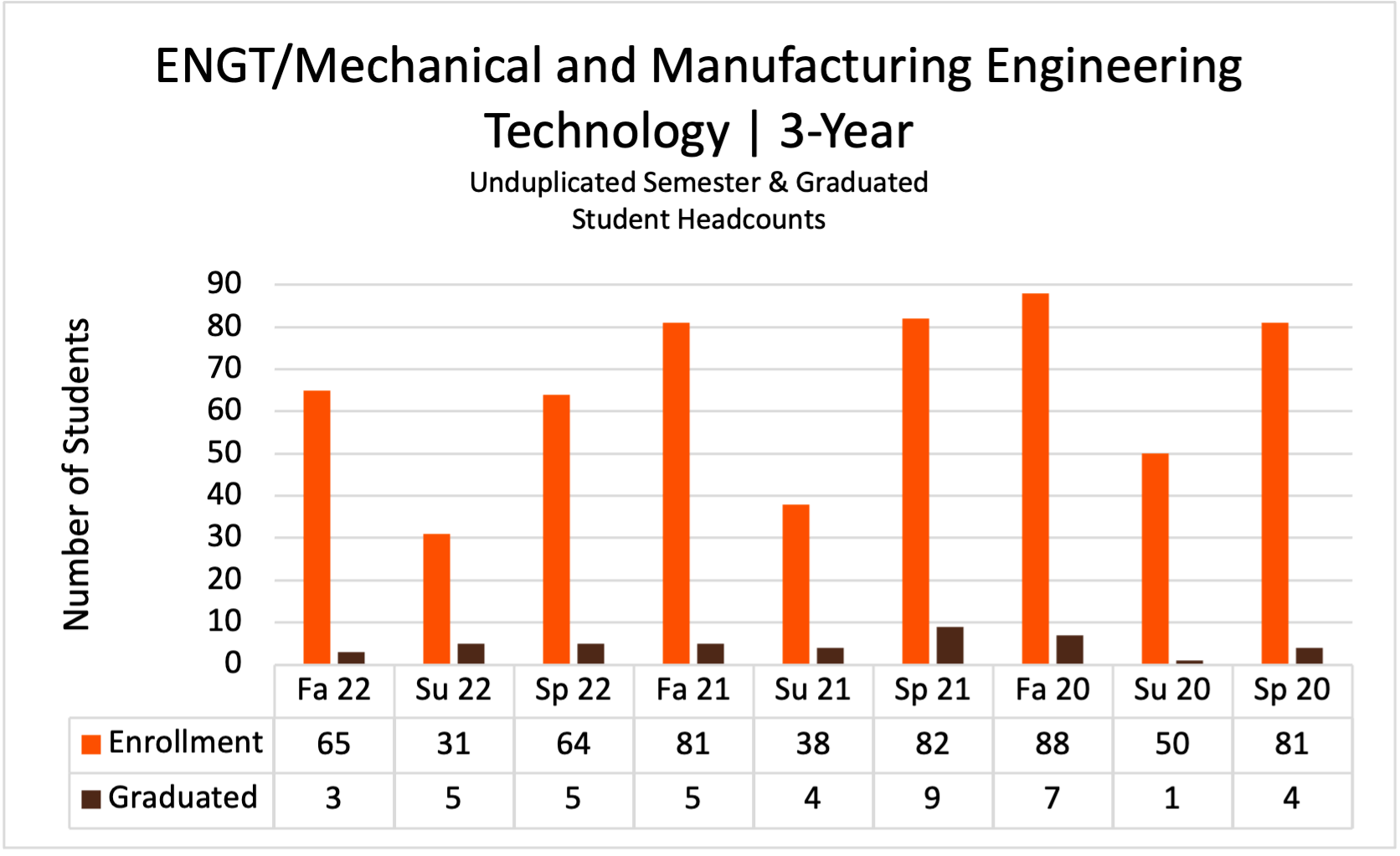
The Electronics and Computer Engineering Technology (ECET) program is accredited by the Engineering Technology Accreditation Commission of ABET, https://www.abet.org.
Program Educational Objectives
The Electronics and Computer Engineering Technology program at BGSU expects the graduates within a few years of graduation to attain the following Program Educational Objectives (PEO).
- PEO 1: The Electronics and Computer Engineering Technology program prepares exemplary electronic and computer engineering technology professionals who are problem solvers in the areas of instrumentation and process control, communications and computer networking, computer technology, electric machinery and power systems, and renewable energy;
- PEO 2: The program will prepare graduates to work as effective employees and team members and to possess appropriate oral and written communication skills; and
- PEO 3: The program will prepare graduates to value their profession and to recognize the global impacts of their profession on society. They will recognize their professional need to advance in their careers and continue their professional development.
Student Outcomes
Upon completion of the baccalaureate degree, students in the Electronics and Computer Engineering Technology program will be capable of the following Student Outcomes (SO).
Program-relevant learning outcomes of the Electronics and Computer Engineering Technology major include:
- SO 1: An ability to apply knowledge, techniques, skills and modern tools of mathematics, science, engineering, and technology to solve broadly-defined engineering problems appropriate to the discipline of Electronics and Computer Engineering Technology;
- SO 2: An ability to design systems, components, or processes meeting specified needs for broadly-defined engineering problems appropriate to the discipline of Electronics and Computer Engineering Technology;
- SO 3: An ability to apply written, oral, and graphical communication in broadly-defined technical and non-technical environments; and an ability to identify and use appropriate technical literature;
- SO 4: An ability to conduct standard tests, measurements, and experiments using skills appropriate to Electronics and Computer Engineering Technology and to analyze and interpret the results to improve processes; and
- SO 5: An ability to function effectively as a member as well as a leader on technical teams.
EET Outcomes:
- SO 1: The application of circuit analysis and design, computer programming, associated software, analog and digital electronics, and microcomputers and engineering standards to the building, testing, operation, and maintenance of electrical/electronic(s) systems;
- SO 2: The application of natural sciences and mathematics at or above the level of algebra and trigonometry to the building, testing, operation, and maintenance of electrical/electronic systems;
- SO 3: The ability to analyze, design, and implement one or more of the following: control systems, instrumentation systems, communication systems, computer systems, or power systems;
- SO 4: The ability to apply project management techniques to electrical/electronic(s) systems; and
- SO 5: The ability to utilize differential and integral calculus, as a minimum, to characterize the performance of electrical/electronic systems.
CET Outcomes:
- SO 1: Application of electric circuits, computer programming, associated software applications, analog and digital electronics, microcontrollers, operating systems, local area networks, and engineering standards to the building, testing, operation, and maintenance of computer systems and associated software systems;
- SO 2: Application of natural sciences and mathematics at or above the level of algebra and trigonometry to the building, testing, operation, and maintenance of computer systems and associated software systems;
- SO 3: Analysis, design, and implementation of computer system hardware and software;
- SO 4: Application of project management techniques to computer systems; and
- SO 5: Utilization of statistics/probability, transform methods, discrete mathematics, or applied differential equations in support of computer systems and networks.
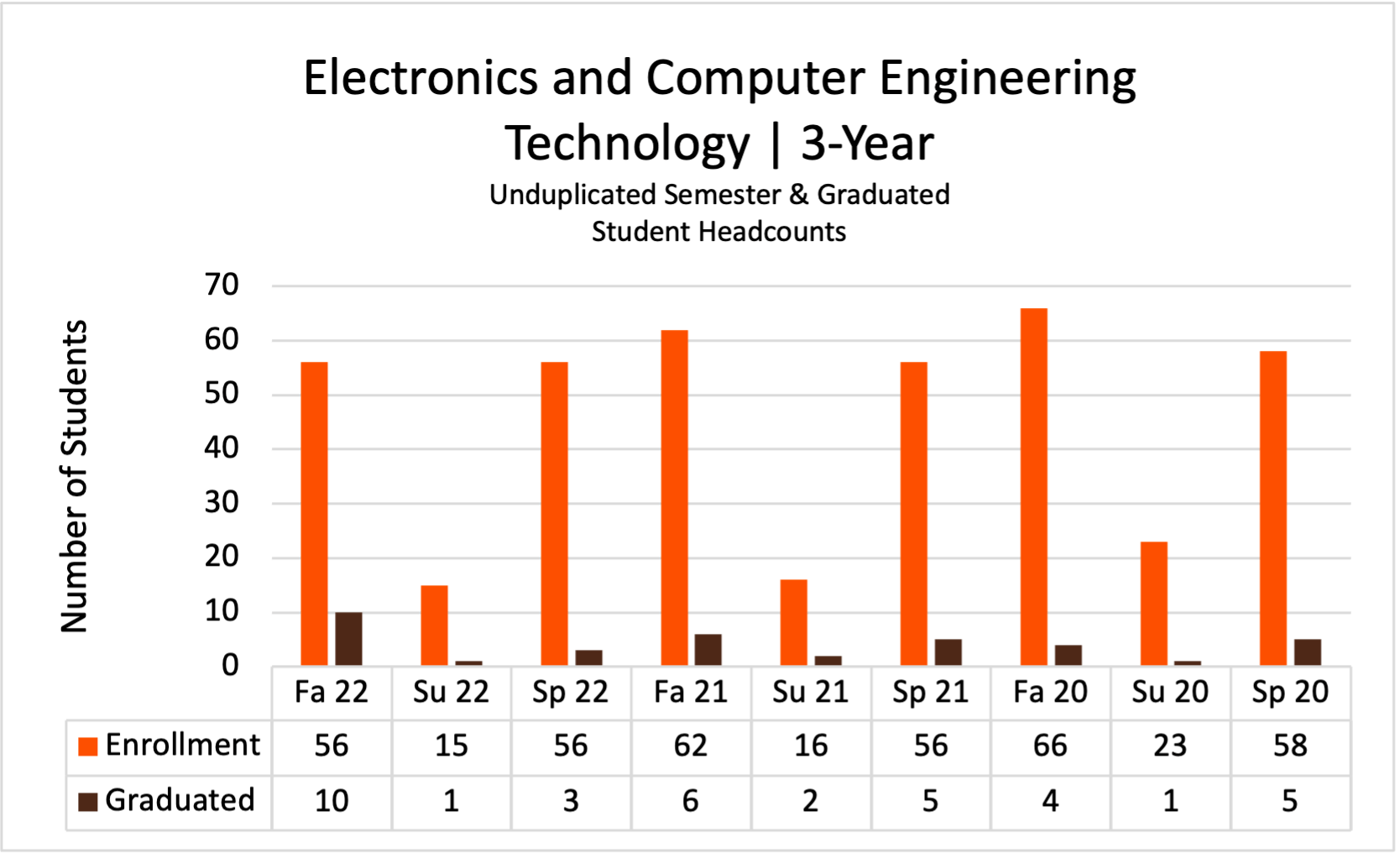
The Mechatronics Engineering Technology program is accredited by the Engineering Technology Accreditation Commission of ABET, https://www.abet.org.
Program Educational Outcomes
The Mechatronics Engineering Technology program at program at BGSU expects the graduates within a few years of graduation to attain the following Program Educational Objectives (PEO).
- PEO 1: Graduates will be able to combine knowledge with modern tools to solve real-world interdisciplinary engineering problems related to electromechanical systems and advanced manufacturing and robotics systems;
- PEO 2: Graduates will be able to function effectively as a member as well as a leader on technical teams; and
- PEO 3: Graduates will be able to demonstrate continuous professional improvement including commitment to ethical responsibilities in their profession.Student Outcomes
Student Outcomes
Upon completion of the baccalaureate degree, students in the Mechatronics Engineering Technology program will be capable of the following Student Outcomes (SO):
- SO 1: An ability to apply knowledge, techniques, skills and modern tools of mathematics, science, engineering, and technology to solve broadly-defined engineering problems appropriate to the discipline;
- SO 2: An ability to design systems, components, or processes meeting specified needs for broadly-defined engineering problems appropriate to the discipline;
- SO 3: An ability to apply written, oral, and graphical communication in broadly-defined technical and non-technical environments; and an ability to identify and use appropriate technical literature;
- SO 4: An ability to conduct standard tests, measurements, and experiments and to analyze and interpret the results to improve processes; and
- SO 5: An ability to function effectively as a member as well as a leader on technical teams.
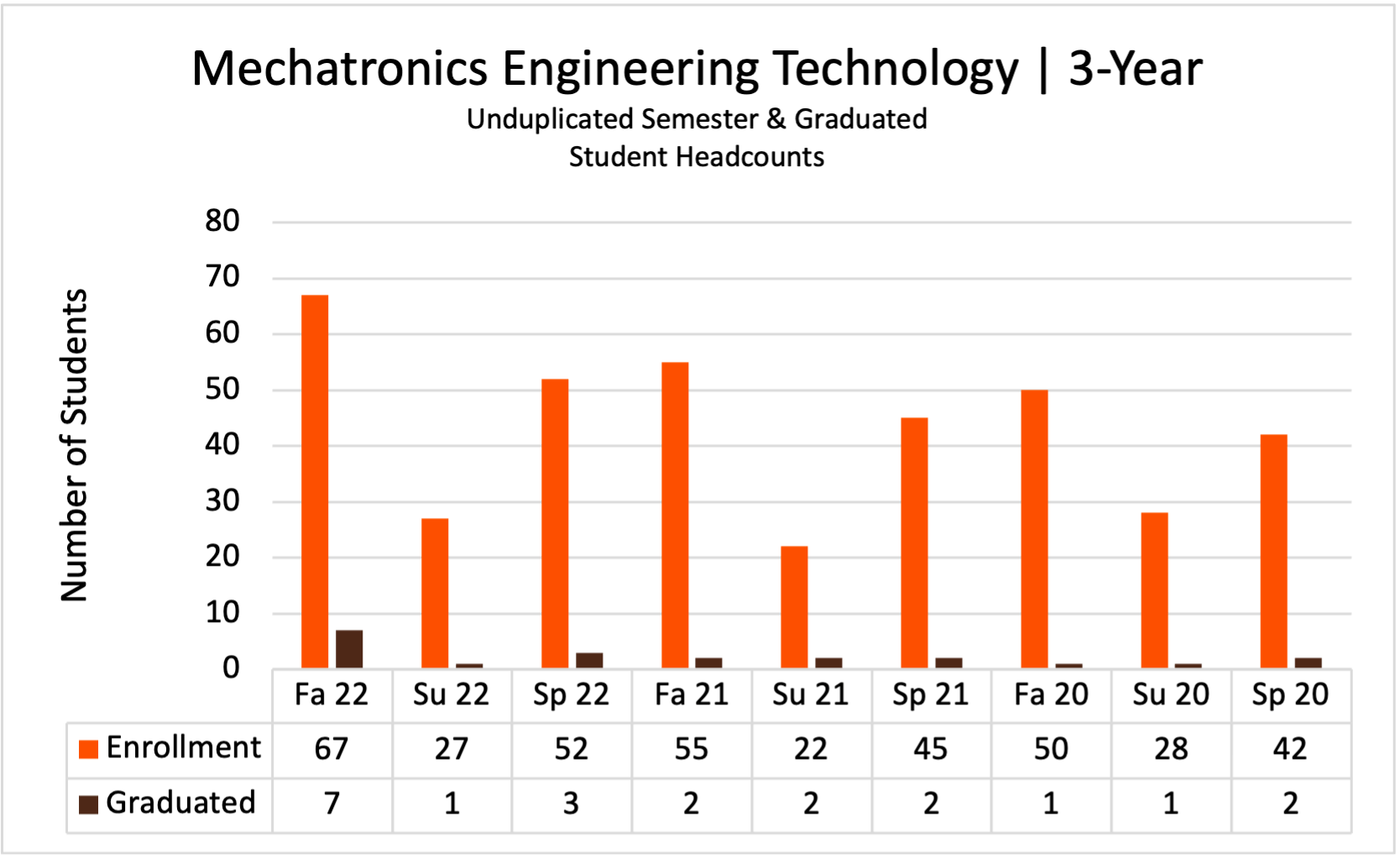
The Quality System Technology program is accredited by the Engineering Technology Accreditation Commission of ABET, https://www.abet.org.
Program Educational Outcomes
- PEO 1: The Quality Systems Technology program prepares individuals to be proficient in the areas of quality improvement, process improvement, quality leadership and proficient in application of quantitative and qualitative quality tools within a manufacturing and/or service environment;
- PEO 2: The program will prepare graduates to function as an individual, effective team member, and quality professional using oral and written verbal communication skills; and
- PEO 3: The program will prepare graduates to value their profession and to recognize the global impacts of the quality profession on society. Graduates will recognize the professional need to continually improve and stay current in their career while executing the duties of a quality professional in an ethical fashion as described by the American Society for Quality (ASQ).
Student Outcomes
Upon completion of the baccalaureate degree, students in the Quality Systems program will be capable of the following Student Outcomes (SO):
- SO 1: An ability to apply knowledge, techniques, skills and modern tools of quality, mathematics, science, engineering, and technology to solve broadly-defined quality related problems appropriate to the quality systems discipline;
- SO 2: An ability to design quality management systems, components, or processes meeting specified needs of stakeholders for broadly-defined quality related problems appropriate to the discipline;
- SO 3: An ability to apply written, oral, and graphical communication in broadly-defined technical and non-technical environments; and an ability to identify and use appropriate technical literature;
- SO 4: An ability to conduct quality assurance related standard tests, measurements, and experiments and to analyze and interpret the results to reduce variation and improve processes; and
- SO 5: An ability to function effectively as a member, as well as a leader, on technical and project teams.
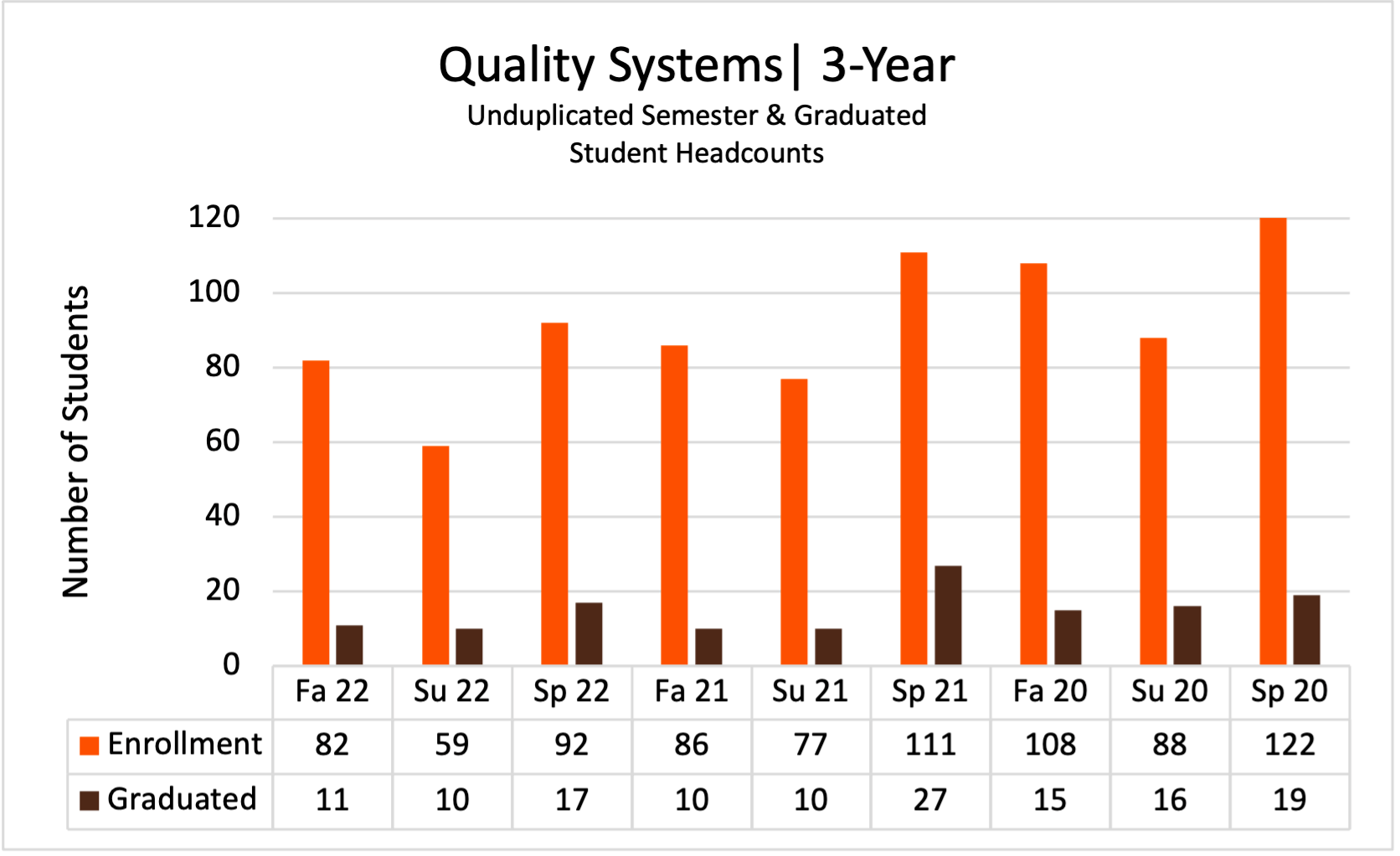
Updated: 06/22/2023 10:27AM
